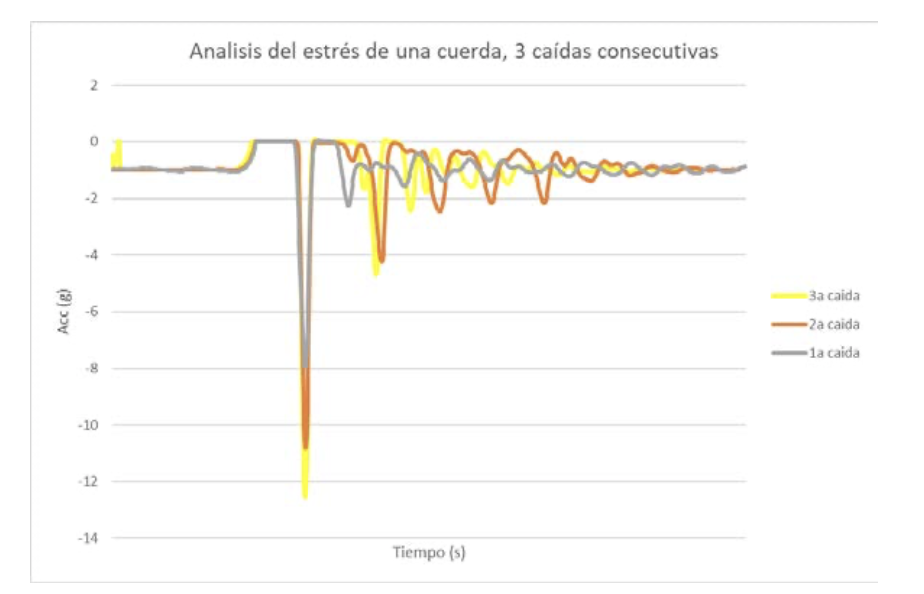CLIMBING
INTRODUCTION AND MOTIVATION
Validation with acceleration range increase:
The reconfigurable measurement range of the IMU has been increased to ±16g, and new weighted drop tests have been carried out at the facilities of the University of San Jorge (Zaragoza), a participant in the technological network of this project.
DEVELOPED PROTOTYPE
RESULTS AND CONCLUSIONS
The sample of falls cushioned by climbing ropes was expanded, the different types of ropes analyzed were increased to three, and the stress suffered by a rope during three consecutive falls was analyzed. The dynamic string used was a 9.8mm Beal Karma. The static string model is a 10mm Korda ́s Dana. The safety cord was a Beal Aramide 5.5 mm. A 20 kg weight was dropped into a vacuum from a height of 2 m (drop factor 0.5), with an IMU attached to it. Acceleration was recorded with the 200 Hz setting and sent directly to the PC via Bluetooth. Figure 8 shows the acceleration in three consecutive falls, with less than five minutes between them. An advanced analysis of these data, which is currently being worked on, could make it possible to establish better and safer practices in activities that involve possible falls cushioned by ropes, such as a "flight" or fall during the ascent of a climbing route.

Vertical acceleration recorded in three consecutive falls for the static rope, Korda ́s Dana 10 mm.
Calculate and analyze the coefficient of impulses in the advance of the climbers (task T5B):
The entropy of a climber's movement was analyzed during five repetitions of the same climbing boulder (short route, 3-4 meters, without safety ropes). The IMU was fixed to the lumbo-sacral area of a climber. Acceleration was recorded with the 200 Hz setting and sent directly to the PC via Bluetooth. The objective was to analyze the accelerations in the three axes and how they varied as the climber repeated the movement, in order to study the entropy (quantification of disorder) of the movement. Figure 9 shows the accelerations in the three axes. In order to perform a more advanced analysis, it would be necessary to apply this protocol to a sample of 15-20 subjects.

Acceleration values recorded during the “on sight” climbing of a route in the first and fifth repetition.
PEOPLE AND INSTITUTIONS INVOLVED
Isidoro Ruiz-García1
Ismael Navarro-Marchal2
Juan A. Moreno-Pérez1
P. Lorenzo Uhrich3
Alberto J. Palma1
Pablo J. Gómez-López2
Miguel A. Carvajal1
1 ECsens, Department of Electronics and Computer Technology, Sport and Health University Research Institute (iMUDS-UGR), Research Centre for Information and Communications Technologies (CITIC-UGR), University of Granada, 18071 Granada, Spain.
2 SkiingLab, iMUDS, Department of Physical and sport education, Sport and Health University Research Institute (iMUDS-UGR), University of Granada, 18007 Granada, Spain.
3Kustom Skis S.L., Calle Pérez Ayuso, 9, 28002 Madrid, Spain
This work was partly supported by Consejo Superior de Deportes through projects Project: “SensorSportLab III”, (Redes de Investigación en Ciencias del Deporte 2024) by Consejo Superior de Deportes (Ministerio de Cultura y Deporte), and European Regional Development Funds (ERDF).
Thanks also to Kustom Skis for allowing the prototype ski manufacturing at their facility.






